(Note: Continued from Part 5)
White Hands
One thing that's fascinated me about the humpback whales that visit Vava'u is the occasional presence of what I call "white hands"…whales that have all, or mostly, white pectoral fins on their dorsal surfaces as well as ventral (i.e., both sides of their pecs).
This is more common among northern hemisphere humpbacks than southern ones. This trait certainly makes it easier to see the whales while they're swimming, and also to recognise individuals in repeat sightings.
Now, here's the thing…in most years, we've seen none of these whales. In a couple of years, there were lots of sightings…on the order of seven or eight individuals. (From memory 2007 was a big white hand year, though I have to double check images to be 100% sure.)
What are these whales? Where are they from? Why do they only appear from time to time? Is there any possibility that some whales have crossed over from the north and brought the genetic trait, or has it evolved by chance down here?
Anyway, this is shaping up to be another year with zero or near zero sightings. The closest we have is this whale, which was one of three males that essentially dive-bombed a mother and calf (Yoshi, calf number 9 this season) in a contest to be her escort.
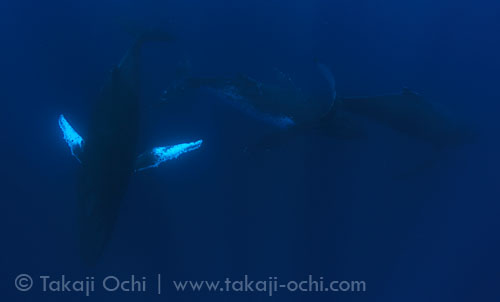
Almost a white hand
It's almost a white hand, thought the dorsal surface of the pectoral fin isn't completely white.
I'm going to start GPS-marking white hand sightings. If you photograph a white hand in Vava'u, please let me know.
Social Interaction
On 30 August, we went to Toku Island, which is about 70km away from Neiafu. The weather window was clear, and the seas were calm.
It was my first trip to Toku, and it didn't disappoint.
We spotted a group of three whales before we even arrived, got in the water, and didn't stop swimming until it was time to go home.

This is what we saw as soon as we dropped in.
The three whales were clearly socialising with one another. There were two large whales with mostly white bellies, and a smaller one that had lots of scratches on its dorsal surface.
They were behaving like a lovey-dovey couple…all touchy-feely, weaving their bodies together, executing pirouette-like moves, and making lots of sounds.
Given that there were three, not two, whales, their behaviour puzzled me. After our first drop, I casually commented that it might be a ménage à trois, with the small one being the female (The other two showed me their "maleness".).

A cyclone of whales
Even though the two larger whales showed their bellies on multiple occasions (making it easy to sex them), the smallest whale didn't. To complicate matters, its underside was mottled with dark blotches, making it even more difficult to ID the sex of the whale in the water.
It wasn't until later that evening that I was able to see enough of the little whale's underside to be certain that it was also a male.
So…following on the Dancing Queen social interaction I described in Part 4, this is another example of highly intimate social interaction among male humpback whales.
I haven't really taken note of such interactions before, but it's possible that I simply overlooked them, or assumed that there was a female involved when there wasn't.
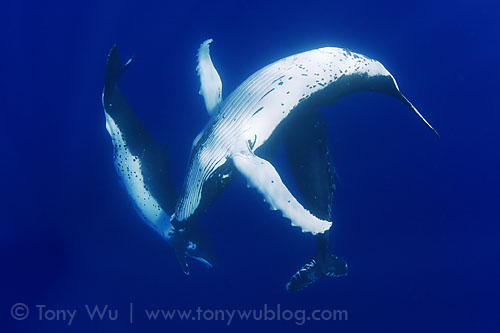
Three male whales socialising at Toku Island
Given that we know that many other cetacean species exhibit intimate social behaviour among males, it might be that this type of behaviour among humpbacks is also relatively common.
In any case, it was quite a spectacle, and the whales let us swim among them for nearly four hours before the group broke up. One whale left the group and a different one joined, completely changing the mood…resulting in rapid swimming which we couldn't follow.
Heat Runs
Heat runs, of course, are among the most energetic and interesting forms of humpback social interaction. There have been quite a few in the past ten days or so, two of which we've been able to see in the water.
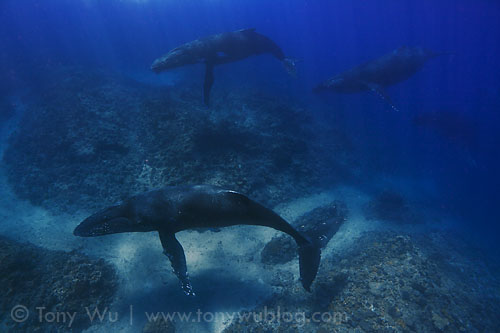
Six-whale heat run passing through the shallows
The first (on 29 August) was a six-whale heat run that we only managed one good drop with, before they decided to take most of the action down deep. We had the good fortune of doing that drop in a shallow area. Watching six adult whales swim over a shallow reef is a powerful and moving experience (such an understatement).
(Note: One of the six whales in this group was singing as it swam in the heat run. We've come across this behaviour several times, twice this season.)
On 31 August, we stumbled upon another heat run, this one comprising seven whales.
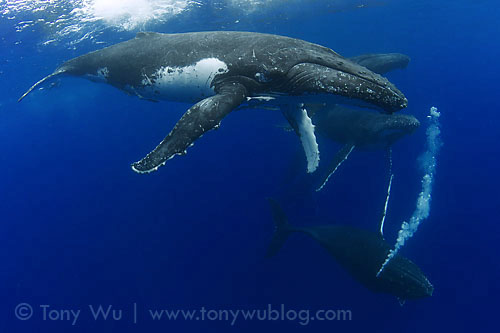
Seven-whale heat run!
I think we came across them just as they were coming together for the heat run, as they clumped together sufficiently to fit into one frame, a rare occurrence, and they also approached us with some measure of curiosity (possibly meaning that they might not have been too engrossed/ preoccupied yet?).
This was the final day on the water for the six people with me on the boat, so it was quite a way to end the trip.
Besides seeing the seven whales mixing it up in the water, everyone saw several full breaches. Of note was one time when I was in the water and saw one of the lead whales take off at high speed ahead of the others.
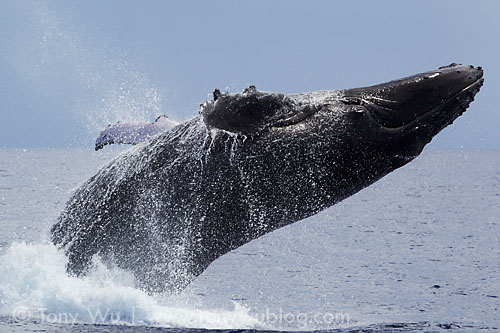
Female whale in the heat run breaching
Knowing from experience that this probably meant an impending breach, I lifted my head out of the water and shouted "BREACH!!!" loudly enough to give the people on the boat a few seconds of advance warning before the whale came flying out of the water about 30 metres ahead of me.
That wasn't the best part though.
Immediately afterward, all of the other whales executed forward face-flop breaches in rapid succession…so, Kaboom! followed by Boom!, Boom!, Boom!, Boom!, Boom!, and Boom!
I watched from the water's surface in absolute awe (and also frustration since I couldn't take photos).
Whales in heat runs often breach, but I've never seen every whale breach in rapid succession like that. It was like having a 21-gun salute with several hundred tonnes of blubber.
What a sight!

The sexy-hot female driving the boys mad
At one point, we watched as a sudden change in mood overtook the whales. Within milliseconds, the whales went from milling around at a relatively leisurely pace to what seemed like a frantic panic. Several whales blew bubbles simultaneously, and then whisked off at super-duper-tremendous high speed.
Back on the boat, we saw that they rendezvoused with three other whales, engaging in what can best be described as a "fracas", until eventually, only six to seven whales were left (out of a total of ten).
We heard from another of my boats that later in the afternoon, a pod of dolphins joined the whales (actually, they zipped in like jet fighters to harass the bigger animals)...making for quite an entertaining spectacle.
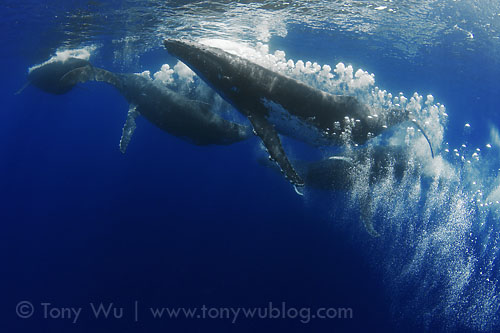
Heat run whales charging off to intercept other whales
Deep Waters: Speculation Update
All these experiences are interesting, but trying to extract meaning from them is a challenge. Spending hundreds of hours in the water with whales over many years and talking with friends who've done the same helps, but the fact remains that we collectively know next to nothing about what these whales do and why they do it.
This season, I've pushed myself to try to pull together experiences and observations (both my own and those of other experienced people here) to try to make some sense of what's going on.
I know it's speculation, but there aren't that many people in the world who've spent so much time in the water observing humpback whales, so I guess I'm as well placed to speculate as anyone else.

Diving humpback whale
To update what I've written in previous posts, I basically still think that a relative abundance of horny males to breeding females is driving much of what we're seeing.
Notably, it seems like there have been a lot of heat runs, with four to seven males to a given female, and we've seen multiple instances of multiple males descending upon a mother and calf, starting very early in the season.
Much of the hormone-driven action seems to be taking place offshore, drawing many whales away from the shallower waters closer to the islands, and hence away from where many whale watch boats are crusing.
This may also help support my notion about Ikumi and her mom…that the scarcity of whales in the waters closer to the islands has resulted in lots of space and freedom from harassment by other whales. Hence, their record 14-day (and counting) stay so far.
In Part 2, I wrote:
"I've also sensed in the past that high-baby years seem to run somewhat countercyclical with seasons with a relatively high number of heat runs and mating pairs. This seems to makes sense, since females with babies are relativley less likely to be engaging in courtship/ mating (though it does happen), while females without babies are relatively more likely to do so.
So…one of the things that will be of interest to me as the season progresses is to see how the baby count goes versus the relative frequency of heat runs and mating pair encounters."
What the final baby count for this year will be still has many weeks to play out, so it's premature to proclaim this a high- or low-baby year, but we have definitely seen a lot of heat runs and apparent mated pairs.
I do have one amendment to make to my speculation though (See Part 4).
I had been conjecturing that there were relatively few breeding females around, in substantial part because of the high number of humpback whale babies over the past several years.
But given the plethora of heat runs we've seen and heard about over the past couple of weeks or so, I'm adjusting a bit, and thinking that perhaps the number of females that "recycled" rapidly and are ready to mate again might actually be relatively high.

Four of seven whales in a heat run
This might seem contradictory to what I wrote in earlier posts, but it's not. I still think the baby boom last year underlies much of what's going on, but instead of positing that having most or all of those females out of breeding circulation this year would mean lower breeding-related activity through the season, I'm starting to think that the females that were recent mothers might be "recycling" faster than I expected, and getting back into the mix to reproduce again.
If this were the case, we'd still see relatively fewer babies this year (at least in comparison to last year), but there would be more breeding-ready females in circulation.
The early sightings of mated pairs and relatively early sightings of mothers and calfs with one or more escorts could still mean that there is high competition for females. But if a substantial number of young females joined the breeding-ready population and already mature ones recycled rapidly to reproduce again, that might contribute to the frequency of heat runs we've encountered.
If something along these lines is taking place, we might, then, see another uptick in the baby count next season.
And again, the possibility that I'm completely wrong is always out there.
People
What can I say? I've been incredibly fortunate people-wise.
Whenever I put together a group of people for an extended trip, my biggest concern is incompatibility. Sometimes people just don't see eye-to-eye. That's part-and-parcel of being human.
Fortunately, all my groups have been fantastic. This latest one, comprising four people from Singapore, one from the US and one from Sweden, was an absolute pleasure to have here.

Front: Rachel, Serene, May; Back: Maria, David, Patrik
Just having nice people who get along well isn't enough for a trip like this. Even though it's a holiday for everyone, there's a lot of hard work involved too.
Our daily schedules are always demanding, sometimes reaching the point of qualifying as grueling, and I take my time with the whales very seriously, so I'm highly appreciative when my fellow travellers do so as well.
Of course, this doesn't mean we didn't have fun. We had loads of it…thanks to everyone's terrific attitude, well-developed sense of humour, and ability to put up with my (nonstop) nonsense.
Just so you don't get the mis-impression that I was the only one being silly, here's a short video that pretty much encapsulates what the past ten days was like (video courtesy of David):
Thank you Serene, May, Rachel, Maria, David and Patrik for being such fabulous companions!
Related Posts
Humpback Whales in Tonga 2010 | Part 1
Humpback Whales in Tonga 2010 | Part 2
Humpback Whales in Tonga 2010 | Part 3
Humpback Whales in Tonga 2010 | Part 4
Humpback Whales in Tonga 2010 | Part 5
Humpback Whales in Tonga 2010 | Part 7
Humpback Whales in Tonga 2010 | Part 8